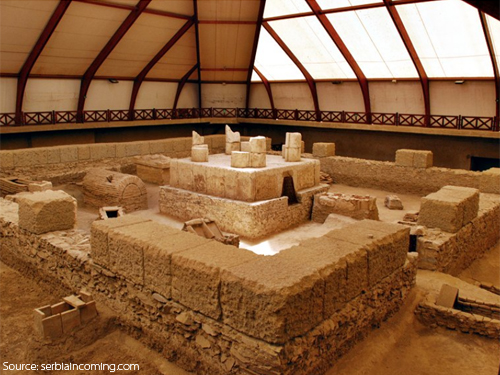
Viminacium, today Kostolac located near Pozarevac, is a home to one of the amazing archaeological park and unique tourist attraction. Viminacium was the capital of the Upper Moesia /Moesia Superior/ Roman Province and the military camp of the Roman Legio VII Claudia Pia Fidelis in the period from the 1st until the 4th century A.D. It is situated 4 km from the confluence of the Mlava River into the Danube and 12 km away from the town of Pozarevac and about 90 km south-east of Belgrade. From its foundation until this day Viminacium makes one of the most significant cultural sites of Serbia.
Viminacium is believed to have had some 40,000 inhabitants, making it one of the biggest cities of that time. Devastated by the Huns in the 5th century, it was later rebuilt by the Emperor Justinian but completely destroyed by the Slavs in the 6th century.

Christ’s monogram from 2nd century was discovered in Viminacium archaeological site and represents the oldest proof of early Christianity in this region. In Viminacium are also discovered Emperor Hostelian’s mausoleum, temples, thermal baths, the north gate of the Military camp, an aqueduct and Roman Pantheon and Amphitheater. The Thermal baths of Viminacium are distinguished not only by their luxury but also by their architectural design.
Today, the Viminacium archaeological site contains remains of streets, temples, squares, amphitheaters, palaces, hippodromes and Roman baths. It has also for years represented a good example of combining science and entrepreneurship, being the best-run archaeological site in Serbia - whose territory was home to 17 Roman emperors.

The discovery of an extraordinary record of the whole postcranial skeleton and one part of skull of the fossil proboscidean Mammoths sp. has given a special charm to this location. It is the oldest representative of genus Mammoths (mammoth) – species M. meridionals and belonged to a male Mammoths that reached Europe from South Africa few million years ago. This finding in Viminacium Archaeological site – in 2009 – makes an important phenomenon not only for Serbia but also for the natural history of the whole planet. Three years later there have been seven more mammoth skeletons found at the Viminacium site.
Today, Viminacium is a scientific-research center which is being turned into an archaeological park and tourist attraction with an authentic Roman ambience where tourists can have a Roman lunch and spend a night at the Viminacium site. Souvenir shop is enriched with wine, pottery, jewelry, souvenirs and brochures resembling Viminacium period.
The archaeological site is open for visiting from the beginning of February to the end of November, from 10am to 5pm. Pre-arranged visits can be organized all year round, including outside the above dates and times.
More info HERE.